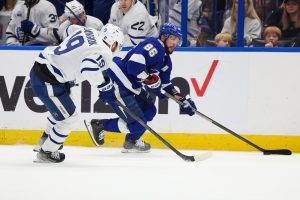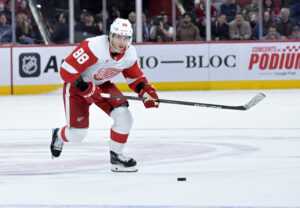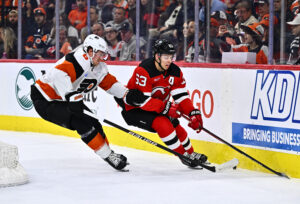The first overall pick in any draft is sacred. You can have any player on the board that you want. If there is a bonafide superstar available, they are yours for the taking. But for every Connor McDavid, there is a Nail Yakupov. No prospect is a sure thing, no matter how many analysts tell you otherwise on draft night. If that budding star gets drafted in the first round, all eyes are on him. And with the attention, comes the pressure of playing in the big league. For a rookie to make the NHL roster at 18-years-old should be an accomplishment. But for fans and front offices, that isn’t enough anymore.
There is Too Much Pressure on Young NHL Players
In the 2015-16 NHL season, the hockey world was lit ablaze by a stunning rookie sensation by the name of Connor McDavid. The 18-year-old first overall pick posted 48 points in 45 games before a bad hit broke his collarbone and ended his season. The following year, another first overall pick would do just as well. Auston Matthews put together a 40-goal campaign with the Toronto Maple Leafs and won the Calder Trophy in his rookie NHL season. Matthews was also 18-years-old. These two players set a precedent that highly drafted players not only need to produce, but they need to do it right away.
Players drafted in the top-10 are frequently marked as the future faces of the franchise. We have seen such scenarios come to fruition with the likes of Elias Pettersson, Brady Tkachuk, and Cale Makar. We have also seen plenty of them not pan out. Nolan Patrick, Olli Juolevi, and Lias Andersson are all names that stick out as picks that didn’t work out. Not to say that their careers are over, but they have not lived up to their draft status so far, for one reason or another.
There are three very big names at the forefront of everyone’s mind when we discuss players who haven’t lived up to expectations in the last few years. That includes the top two picks in 2019 and the first overall pick in 2018. Jack Hughes, Kaapo Kakko, and Rasmus Dahlin have not necessarily shown us that they were bonafide superstars right away. But that’s okay. They have shown flashes of exceptional play and the key is that they developed. Not that they lit up the scoreboard from day one.
Rasmus Dahlin
Dahlin drew the short stick in this instance. Drafted first overall by the Buffalo Sabres, Dahlin found himself stuck in hockey hell. The Sabres are a team that has struggled mightily for a decade. As a rookie, Dahlin posted 44 points and showed why he was a top pick. He even finished third in Calder voting. But he has yet to take the next step and just had a tough year on a team that never got the ball rolling. Any rookie in the NHL should consider this a success, but some people in Buffalo saw it differently.
As mentioned before, Rasmus Dahlin just got bad luck with the draft lottery. In his career, a frequent defensive partner of his was Rasmus Ristolainen. The two play a very similar style. Ristolainen tended to be the possession defenceman of the pairing. This forced Dahlin into a more defensive role. Anyone who knows anything about Dahlin when he was coming into the draft knows that he is more of an offensive player. His ceiling on defence is much lower than what he could be capable of offensively. When you consistently mismanage a player’s role on the team and add that to a revolving door of coaches, it doesn’t equal success. Dahlin still has time to develop but that window could close in the next few years. Don Granato should help his development immensely by bringing stability to the team.
Jack Hughes
Jack Hughes was the second of the three Hughes brothers to be drafted to an NHL team. He is also the one with the highest expectations. The New Jersey Devils won the draft lottery and selected him first overall in 2019. Hughes made the NHL roster right out of the gate. Most would view this as a success. But, high expectations from prior top picks made his development appear underwhelming.
Hughes was put in a reasonably large role straight away. He found himself on a line with Taylor Hall and Kyle Palmieri at times as a rookie in the NHL. While that ice time he is getting is good, you are putting a lot of pressure on a young guy to produce right away when you put him on a line with a former MVP. When not playing with the two of them, Pavel Zacha and Wayne Simmonds were his most common linemates. This role was more suited to his skill level at the time. It gives him NHL experience while not pressuring him to produce at a high rate immediately.
Hughes Progessed
We saw growth in year-two. Jack Hughes had 21 points in 61 games as a rookie. But in his second year, he managed an additional 10 points, putting him at 31 points in 56 games. That’s an increase from 0.34 points per game to 0.55 points per game. If he can continue that trend, the Devils won’t have to wait much longer until they have a bonafide first-line centreman to rely on. His goal numbers won’t wow you, but that was never his primary skill. He will rack up points throughout his career with assists.
It’s worth noting that Hughes’ partners shifted to mainly Yegor Sharangovich and Janne Kuokkanen last season. The coaching staff should try and keep them together. Hughes had a better year with them and if it’s not broken don’t fix it.
Kaapo Kakko
In 2019, the New York Rangers drafted right-wing Kaapo Kakko with the second overall pick, behind Jack Hughes. Kakko was another player who made the NHL right away, although some speculated he may have been better off spending a year in the AHL with the Hartford Wolfpack. Kakko struggled at times as a rookie. That’s to be expected from any 18-year-old playing in the best hockey league in the world. If you want to categorize his struggles, just look at the role he was forced into. Kakko is a top-six forward. He does not have the skill set of the third-line player he was forced to be. He spent most of the year playing with some combination of Filip Chytil, Brett Howden, and Brendan Lemieux. This brings us to our second issue with Kakko.
Kakko went from being a middle-six forward, to their top offensive option on the right side. That kind of increase in role could stunt his development. Instead of easing him into a position where he gradually becomes a top-line forward, they rushed him into a situation he was not prepared for. Moving him to the second line would have been more beneficial. In terms of offensive output, Kakko stayed roughly the same, improving marginally in points per game. We saw significant strides in his defensive game. His Corsi for percentage increased by 5.5 percent. Improving his possession game is the first step to a boatload of points. But with the safety net of Pavel Buchnevich gone, Kakko appears to be the top guy on the Rangers right-wing.
Alexis Lafreniere
While he does make this list, he doesn’t have as much pressure on his shoulders as the other three. Alexis Lafreniere has only seen one year of NHL action and was drafted first overall in 2020. In 56 games, he put together a 21-point campaign, which is better than some other names seen here. As long as he continues to develop, he won’t find himself here next year. The biggest concern is his ice time. Lafreniere is buried on the Rangers’ depth chart behind Artemi Panarin and Chris Kreider. Similar to Kakko, he would be best suited to develop on a second line. If they want to get the 2020 first overall pick into significant ice time, someone has to switch sides.
Current NHL Comparables
A top draft pick is not a guarantee. Plenty of players flame out of the NHL faster than you could imagine. Rasmus Dahlin, Jack Hughes, and Kaapo Kakko could still be that. We won’t know for several more years. But they are far from the first to have early career struggles. We should take a look at some current NHL stars who didn’t start their careers quite as hot as they are now.
Seth Jones
Seth Jones is just one comparable to Rasmus Dahlin in this instance. Jones became one of the league’s best defencemen with the Columbus Blue Jackets. Like Dahlin, Jones broke into the league immediately after his draft. He didn’t spend any significant time in the minors. He didn’t get off to a great start as a rookie with just 25 points. Jones’ Corsi metrics were even negative his first year. But he grew with time. It wasn’t until his fourth NHL season that Jones broke out and became the sensation that we know him as today. However, the catalyst that sparked his breakout was a trade away from the team that drafted him, the Nashville Predators. Sabres fans will surely hope that isn’t the case with Dahlin.
Tyler Seguin
Many will look at this and say that Tyler Seguin didn’t start his career that slowly. After all, he did win the Stanley Cup in his rookie NHL season with the Boston Bruins. But when we look at his individual stats, they don’t glow quite as much. He played in 74 games and only put together 22 points. That 0.29 points per game rate is worse than any other player discussed above in their first NHL season. He also had his worst career relative Corsi for rate of -2.0, which is the only negative rating in his 11-year career. Look where he is now. He is a top centre for the Dallas Stars and a perennial 70 to 80 points scorer. The second overall pick of 2010 has done well for himself.
Leon Draisaitl
As a rookie in the NHL, big things were expected of Leon Draisaitl. He was drafted third overall by the Edmonton Oilers out of Germany in 2014. He didn’t disappoint in his first season but he didn’t turn heads either. Draisaitl only suited up for a total of 37 contests and put nine points on the board. He would have had a worse offensive season than Seguin. His possession numbers looked good, but not good enough to impress anyone. The following year he broke out for 51 points and developed his game further. The 25-year-old centreman is already solidifying himself as the best German-born NHL player ever with two 100-point seasons and an MVP in his trophy case.
Looking to the Future
Dahlin, Hughes, and Kakko are far from the only players currently facing this issue. The expectations for these young NHL stars are through the roof. They already have enough pressure on their shoulders just based on draft status. By expecting instantaneous results from them, we set them up to fail. Over the next two years, we will see potential superstars like Shane Wright, Matthew Savoie, and Connor Bedard find their NHL teams. They could watch promising NHL careers disappear before their eyes as a media circus swarms them with unmatchable expectations. The key to any player’s development is to not rush the process. It would be a shame to watch such a talented crop of players fall victim to this problem plaguing nearly every rookie around the NHL.
Main Photo:






